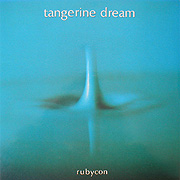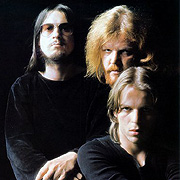| Artist: Tangerine Dream Album: Rubycon Released: 21 March 1975 |   |
|
The "Me Decade" of music is now a world apart from our own. Back then a significant portion of the record buying public was supporting innovative music releases, and the Virgin Records label was feeding this demand with a range of titles that would eventually attain classic status among fans of Rock n' Roll as well as the aspiring genre of Spacemusic.
Throughout the early 1970s Tangerine Dream and their contemporaries in Berlin began to establish an as yet unheard musical form. The previously known trends in music would not allow these groups to properly express themselves, and what with electronic and synthesizer technologies becoming more available a groundbreaking new music manifested itself - one which used an unfamiliar futuristic instrument and was fueled by a passionate disengagement with the past.
After several early releases of surreal sound collage Tangerine Dream produced the groundbreaking The three separate sections of Rubycon Part 1 and Part 2, although significantly different from one another, worked together to form a fascinating whole. Each realization begins with an eerie amorphous interlude of drones, metallic tones and wondrously modulated aural accents. The mounting tension resolves with the emergence of an ever repeating pattern of propelling bass tones, above which is played the lilting melody of a soft synthesizer lead. The minimalist sequence runs on, then gradually brightens as individual notes are transposed and repeated - minutely altering the pattern and quickening the music's pulse. Transitioning out of this energetic phase the magical beauty of the closing section solemnly brings the piece to its conclusion.
The overall effect offered a strange and novel kind of cognitive disengagement - the unusual idea of traveling while sitting in place, which has yet to be fully explained or replicated by musicians who have followed. The generations after the Rubycon era may come close to achieving the evocative mood and - Chuck van Zyl/STAR'S END 3 January 2014 | |
| Reviews |